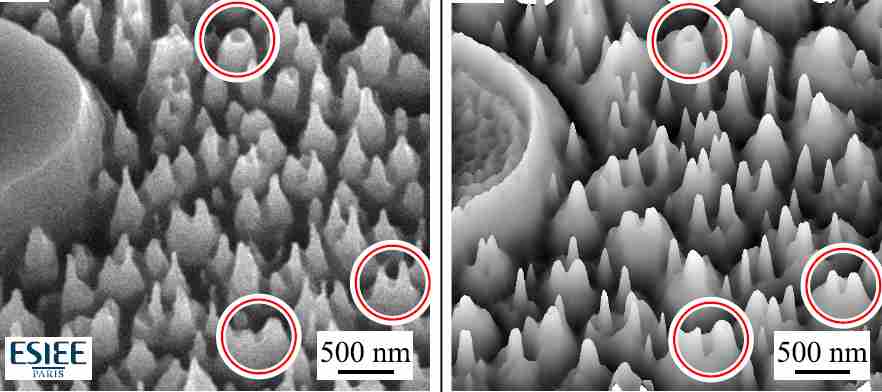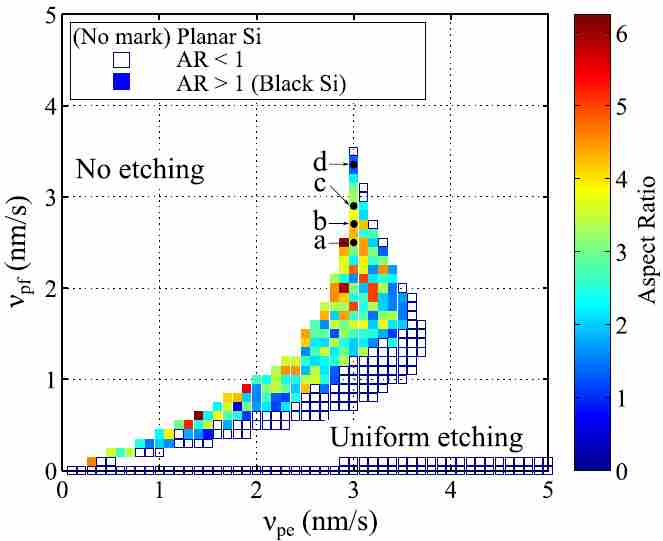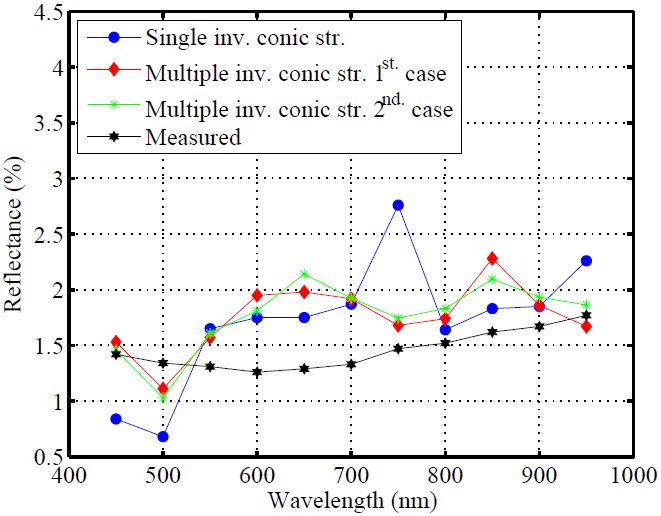Project Black
Silicon
(2012-2015)
"Black Silicon optical properties and growth mechanisms"
Objectives
Black Silison (BSi) are silicon micro and nanostructured surfaces typically fabricated with cryogenic deep reactive ion etching (cryo-DRIE). These self-generated surfaces can be fabricated in a single step procedure and provide large surfaces with reduced reflectance over a broad range of wavelengths and angles of incidence. BSi has been used in a wide range of applications, like high-efficiency absorbers for solar cells, infrared-optimized photodetectors, or superhydrophobic surfaces that can find applications in microelectromechanical devices such as sensorsWe have developed in this project three main state-of-the art contributions:
- a better understanding of BSi topography thanks to a novel BSi topographical characterisation technique which is based on in-plane focused ion beam nanotomography and can reproduce sample details with excellent accuracy,
- insights into its formation mechanism,
- and a modelling of its optical behaviour.
Results
Three-dimensional BSi reconstruction
We developed 2 reconstruction techniques to obtain a three-dimensional model of the BSi topography based on:- Focused ion beam (FIB) nanotomography,
- SEM grey-level analysis.

SEM close-up view of a BSi
sample (left) and its 3D reconstruction
with the FIB nanotomorgaphy (right).
We developed a model that is capable of simulating the entire evolution of a surface from a planar substrate to a fully-developed BSi topography. We showed that the observed evolution of BSi from a planar substrate can be accurately modelled by including the long-range effects of geometric occlusion (or self-shadowing), and no role for defects or micromasking. This is the first successful attempt to model such high aspect ratio structure formation. The dynamics of BSi formation, including the early-stage development of new etch fronts at topological saddle points (reported for the first time), as well as the late-stage evolution of aspect ratio with process time, are correctly predicted by the model.

SEM image (left) and model result (right) after a 2 min time-lapse experiment.

Phase diagram of BSi aspect ratio dependence on passivation layer formation rate (vpf) and passivation layer etching rate (vpe).

Static and dynamic aspects of black-silicon formation
While the effects of each cryo-DRIE
parameter on the formation of BSi have been previously described,
including the molecules interactions between the plasmas and the
substrate that allow the formation of microstructures, the mechanism by
which a complex topography such as BSi can be generated from a flat
surface is not currently well understood.
We developed a model that is capable of simulating the entire evolution of a surface from a planar substrate to a fully-developed BSi topography. We showed that the observed evolution of BSi from a planar substrate can be accurately modelled by including the long-range effects of geometric occlusion (or self-shadowing), and no role for defects or micromasking. This is the first successful attempt to model such high aspect ratio structure formation. The dynamics of BSi formation, including the early-stage development of new etch fronts at topological saddle points (reported for the first time), as well as the late-stage evolution of aspect ratio with process time, are correctly predicted by the model.

SEM image (left) and model result (right) after a 2 min time-lapse experiment.
The resulting simulation model corroborated with experimental
observations allowed us to create a phase diagram that indicates the
combination of control parameters giving rise to BSi formation, and
their effect on the final BSi aspect. The complex geometry of BSi,
consisting of needles and holes of various heights and depths, is
captured by the model and explains the exceptionally low reflectivity
of BSi.

Phase diagram of BSi aspect ratio dependence on passivation layer formation rate (vpf) and passivation layer etching rate (vpe).
BSi optical modeling
Optical modelling of subwavelength structures is a crucial step to find the optimal topographic parameters that provide reduced reflectance, increased absorbance and that meet additional constrains imposed by the application. In order to simulate micro/nano-textured surface such as BSi using FTDT, FEM or RCWA technics, it requires:- to model a unit cell that represents a typical structure representative of the surface. Then boundaries are imposed in this unit cell in order to represent an infinite array of structures,
- to provide the material bulk complex relative permittivity and permeability in function of frequency.

Comparison of reflectance simulation with single and multiple equivalent structures based on dimensions obtained from BSi sample nanotomography with their respective measured reflectance.
Related publications
Journals
-
 “Static and dynamic aspects of
black silicon formation”, D. Abi Saab, P. Basset, M. J.
Pierotti, M. L. Trawick and Dan E. Angelescu, AIP Physical Review Letter, 113, 265502 (2014)
“Static and dynamic aspects of
black silicon formation”, D. Abi Saab, P. Basset, M. J.
Pierotti, M. L. Trawick and Dan E. Angelescu, AIP Physical Review Letter, 113, 265502 (2014)
 “Effect of black silicon disordered
structures distribution in its wideband reduced reflectance", D. Abi Saab, S. Mostarshedi, P. Basset,
S. Protat, D. Angelescu and E. Richalot, IOP Material Research Express, 1 (2014) 045045
“Effect of black silicon disordered
structures distribution in its wideband reduced reflectance", D. Abi Saab, S. Mostarshedi, P. Basset,
S. Protat, D. Angelescu and E. Richalot, IOP Material Research Express, 1 (2014) 045045
 "On the optical and morphological
properties of microstructured Black Silicon obtained by cryogenic-enhanced
plasma reactive ion etching", K. N. Nguyen, P. Basset, F. Marty, Y.
Leprince-Wang and T. Bourouina, AIP
Journal of Applied Physics, 113, 194903 (2013)
"On the optical and morphological
properties of microstructured Black Silicon obtained by cryogenic-enhanced
plasma reactive ion etching", K. N. Nguyen, P. Basset, F. Marty, Y.
Leprince-Wang and T. Bourouina, AIP
Journal of Applied Physics, 113, 194903 (2013)
Conferences
 “Prediction of new etch fronts in black silicon
produced by cryogenic deep reactive ion etching”, D. Abi-Saab, P. Basset, M. J.
Pierotti, M. L. Trawick and D. E. Angelescu, Proceeding of the 18th int.
Conf. on Solid-State Sensors, Actuators and Microsystems (Transducers’15), Anchorage,
USA, 2015
“Prediction of new etch fronts in black silicon
produced by cryogenic deep reactive ion etching”, D. Abi-Saab, P. Basset, M. J.
Pierotti, M. L. Trawick and D. E. Angelescu, Proceeding of the 18th int.
Conf. on Solid-State Sensors, Actuators and Microsystems (Transducers’15), Anchorage,
USA, 2015
- D. Abi Saab, P. Basset, M. J. Pierotti, M. L. Trawick, D. E. Angelescu, “Black Silicon Formation in Cryogenic Reactive Ion Etching”, Bulletin of the American Physical Society 60, 2015
- D Abi Saab, S Mostarshedi, P Basset, DE Angelescu, E Richalot, “Optical properties characterization of silicon micro/nanostructures”, Proc. of Design, Test, Integration & Packaging (DTIP’14), Canne, France, 2014
- D. Abi Saab, P. Basset, F. Marty, M. Trawick, D. E. Angelescu, “Accurate 3D reconstruction of silicon micro/nanostructures, based on high resolution FIB-SEM tomography”, Proc. of Design, Test, Integration & Packaging (DTIP’14), Canne, France, 2014
Maintained by Webmaster